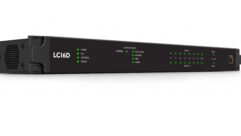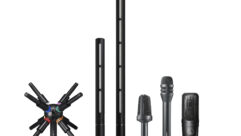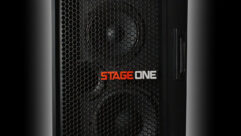How to Design and Build an Audio Network with Products that UtilizeCobraNet Technology
Dec 1, 1997 12:00 PM,
Kevin Gross and Richard Zwiebel
Audio Networks have been a very hot topic lately. Several manufacturershave either announced, or introduced networkable audio products.Specifications are on the streets specifying audio networks, several majorprojects have been installed utilizing the technology, and there have beenmany recent articles on the subject. The incorporation of CobraNettechnology into the products of at least six professional audiomanufacturers (Crown, EAW, L.C.S., Peavey, QSC, and Rane) as themultichannel digital audio and control interface certainly sends a strongmessage to the industry that audio networking has arrived. In the Octoberissue of Sound and Video Contractor Magazine the authors wrote an articlewhich explained what CobraNet technology is.
So now you are ready to design or install your first CobraNet networkedaudio system and you need to know how to start. The purpose of this articleis to explain the real world “hands on ” information of how to design andinstall a CobraNet audio/control network.
Overview of CobraNet TechnologyCobraNet is a data transportation system. It carries multiple channels ofdigital audio, along with control data over standard 100MB Ethernetnetworks. Ethernet is a very well established “standard” for computernetworks, with over 50 million nodes installed worldwide. Products areoffered by numerous vendors, and since it is driven by the huge computerindustry, the cost of the parts and equipment keep dropping. A 100 MB hubthat cost about $2000 one year ago, sells for about $189 today.
How does it work?CobraNet delivers the audio and control data from all input devices to alloutput devices. Each output device has a unique address, each data streambeing transmitted by an input device is directed to one or more outputdevices through this addressing scheme. All audio and control data reachesall devices. Each device “picks off” only the data that is addressed to it.This means that when you are designing your network, you need to beconcerned with good network design practices, rather than which audio isgoing to which node on the network. This is quite different fromtraditional analog audio system design. This also allows for a great dealof flexibility and future changes or upgrades, since these changes will notrequire physical wiring changes, only address changes
Advantages of the Networked ApproachThere are several key advantages to using CobraNet for audio distribution.CobraNet offers an entirely digital solution. This, of course, affordssuperior sound quality but also offers a number of less obvious benefits. Adigital data stream offers more immunity to electrical interference. A datastream delivered via optical fiber offers complete noise and lighteningimmunity for the harshest environments. Even when only copper cabling isused, ground loop issues are handily eliminated by the mandatorytransformer isolation and electrical robustness of Ethernet. Datacommnetworks are designed to carry multiple non-interfering traffic streams.The recent 10 and 100 fold improvements in Ethernet bandwidth allowsCobraNet to deliver at least 64 channels of audio over a single category 5unshielded twisted pair cable or a pair of optical fibers. The capacity ofCobraNet over such commodity cabling results in a significant reduction incabling and infrastructure cost and complexity. Data communicationsnetworks also offer almost limitless flexibility with regards to routing ofdata on the network. This flexibility also carries over to a CobraNetnetwork. An audio channel sourced onto the network is simultaneouslyavailable at any other point or points at any time. There is no need forrewiring or even re-patching to make those inevitable unforeseen audioconnections. In this regards we see CobraNet as the audio distributionsister to field configurable audio processing systems such as Peavey’sMediaMatrix. CobraNet’s flexibility allows unforeseen or overlooked systemrequirements to be accommodated in the field – even at the last minute.Like the configurable processing systems, the operation of a CobraNetnetwork can be reconfigured for special events and the network may beeconomically expanded at any time. Other advantages of the networkedapproach include the ability to centrally monitor the entire network from acentral point or points. And, since CobraNet does not disable any of thestandard data communications capabilities of the Ethernet network, controldata may be carried over the same cables as the audio, eliminating yetanother infrastructure expense and complication.
Designing an Ethernet NetworkWhat are the steps I need to take in designing the network?1. Determine where the audio network nodes need to be located, and how manynodes there will be.
2. Select the audio products that best suit the needs for each location.Products that include CobraNet I/O, can connect directly to theaudio/control network. Products that do not offer CobraNet I/O can beconnected to the network via an interface product such as the RAVE unitsmanufactured by QSC.
3. Determine how many channels of audio need to be transmitted over thenetwork. Also, determine if the network needs to be one large network, ormultiple smaller networks. To do this, first determine if there are certainaudio/control data sources that will never go to certain locations. Anexample of this might be in a theme park where each attraction has audioand control data being transmitted bidirectionally between the attractionand a central equipment room. The audio data from one attraction will nevergo to another attraction, therefore these can be separate networks. Thenext step is to examine the distances and locations, as well as the channelcounts for each node. In the theme park example, if the two attractionswere located close together, while the central equipment room was locatedfar away, it might make sense, from a cabling perspective, to put the twoattractions on the same network. One must also examine the total number ofaudio channels. If there are less than 64 total audio channels, one networkmay be the best choice.
A stadium can be a good example of an application where separate networksare not a good idea. In the stadium, any audio source may want to beoutputted at any node on the network. And the audio routing may change fromone day to the next. As an example, it may be desirable to have a radiofeed come out of the speakers that cover the concession areas during abaseball game, but have an announcer come out of the same speakers during atractor pull. One network allows all inputs to reach all outputs.
A hybrid example might occur in the above stadium, where perhaps, there aretwo meeting room areas that simply need to be tied together in a point topoint manner. In this case, the bulk of the stadium would be on the primaryaudio network, while the two meeting rooms would be on a separate,dedicated CobraNet network
4. Lay out the network design, this includes reviewing the distance rules,selecting the cable type, selecting the network products such as hubs, andlocating the devices and cable run locations. You may have many options andthis is explained with numerous examples in the remainder of this article.
Ethernet OverviewA CobraNet network is an Ethernet network except that instead of connectingcomputers and other data terminal equipment to the network, audio I/Odevices are connected. We’ll start this overview by showing how modernEthernet networks are constructed. While many may be familiar with theoriginal Ethernet networks run over gregarious 5mm or fragile 2mm coaxcable, this type of Ethernet has fallen largely out of favor in the datacommunications industry. The coax has been replaced with cheaper and morereliable unshielded twisted pair cabling. As we’ll see shortly, thevulnerable daisy chained topology of these coaxial networks has given wayto a robust star topology. Twisted pair Ethernet is known as 10BASE-T for10Mbit operation and 100BASE-TX at the 100Mbit rate. Since the older 10MbitEthernet does not provide adequate bandwidth for most audio applications(and is not supported by CobraNet), we will concentrate exclusively on the100Mbit Ethernet for the remainder of this article. The simplest possibleEthernet network is shown in Figure 1. This network allows only two devicesup to 100 meters apart. While Ethernet patch cables are generally wiredstraight pin-to-pin, this network requires a special “crossover cable”wiring – essentially the equivalent of a “null modem” cable for Ethernet.If the 100 meter maximum distance is a problem or if EMI or lightningisolation are desired, the data can be carried over optical fiber (allowingdistances of up to 2 km) as shown in Figure 2. Just as with the twistedpair implementation, 100Mbit Ethernet over multimode fiber has beenstandardized by the IEEE. The multimode fiber incarnation is called100BASE-FX. Both of the “networks” shown thus far may be populated with nomore than two devices. In order to build more realistic networks, acentrally located hub as demonstrated in Figure 3 is employed. A hub is asimple device that combines the data signals from numerous network devicesand routes them back to all other connected devices. Hubs usually displayan array of “idiot lights” which aid in diagnosing network problemsincluding bad or disconnected cables. Ethernet hubs are commodity productsavailable from many manufacturers, distributors and catalogs. 100MbitEthernet hubs are available with 4 to 24 or more ports each and run ascheap as $25 per port. The network shown in Figure 3 could be implementedwith a three port hub if such a thing existed. A four or eight port devicewould probably be specified depending on whether future expansion isforeseen for the network. Swapping out hubs for larger ones is not the onlyway to expand an Ethernet network. Hubs from many vendors are “stackable”meaning that, for instance, a sixteen port hub may be constructed bystacking two eight port devices and attaching a proprietary interconnectcable between them. Hubs may also be cascaded as shown in Figure 4. Any ofthe techniques described thus far for expanding networks can be combined tobuild even larger site-specific solutions. An example of such a solution isshown in Figure 5.
Distance LimitationsIn designing an Ethernet network you must take care not to exceed thecapabilities of the technology. 100Mbit Ethernet requires category 5cabling. The category 5 rating applies not only to the cable itself butalso to the installation and termination thereof. Some care must be takenin these matters – especially for the longer runs. Hand held Ethernet cabletesters are available to measure characteristics and length of installedcables. Ethernet has specific distance limitations. 100Mbit Ethernet can gono further than 100 meters over category 5 cabling. The signal becomes toodegraded and weak over longer distances. Ethernet hubs regenerate the datasignals so a 200 meter run can be achieved if a hub is inserted in themiddle. A far better approach as demonstrated in Figure 2 is to jump tofiber. Signal degradation is much less pronounced over fiber allowing foruninterrupted runs of up to 2 kilometers. Fiber installation is not thepricey rocket science it once was. Fiber optics represents the future (ifnot the present) in infrastructure for large facilities.
Distance limitations due to signal degradation are but one of two types ofdistance limitation imposed on Ethernet installations. The other distancelimitation arises due to timing issues on the network. As a network becomeslarger, it takes more time for a signal (moving almost the speed of light)to travel from the originator to all points on the network. According tooperating principles of Ethernet, it is a requirement that all devices onthe network receive the signal within a certain interval. This timingrequirement has the effect of limiting the maximum diameter of a network.The diameter is essentially the cable distance between the two most remotedevices on the network. If you have two remote equipment rooms withCobraNet DTE devices connected to a hub in a central control room and eachremote equipment room is 500 meters from the central equipment room, thenetworkdiameter is 1000 meters. By keeping the network diameter less than2km for either category 5 cable or fiber optic cable, you do not need to beconcerned about network timing issues. If you must have a network diameterthat is larger than this, you must go through the calculations. Details onaccurately computing a network diameter can be found athttp://www.peakaudio.com/CobraNet – look for “Network ConfigurationGuidelines.” By the book, 100Mbit Ethernet allows a network diameter ofjust over 200 meters. Due to the way CobraNet uses an Ethernet network aCobraNet network may be over 2 kilometers in diameter.
CobraNet DevicesNow that we know how to build 100Mbit Ethernet (and thus CobraNet)networks, we’ll have a look at the devices with which a CobraNet network ispopulated. In the previous figures, these devices have been labeled”CobraNet DTE”. DTE or Data Terminal Equipment is a networking term for anydevice attached to the network. In the case of CobraNet, these devicestransmit and receive digital audio data on the network. Any audio devicessuch as a preamplifier, audio processor, mixer, or amplifier that inputsand/or outputs audio data in the CobraNet format is a DTE.
A key point to understand with CobraNet is that all “CobraNet compliantdevices” have been tested for compliance and will seamlessly interface withall other “CobraNet compliant devices” on the network, regardless ofmanufacturer.
CobraNet CapacityA single CobraNet network has a capacity of 64 audio channels. Unconnectedaudio inputs will consume audio channels on the network. If the designexceeds CobraNet’s capacity, you’ll first want to check your design to seewhether you are efficiently using the network. As an example, you may besending the same 8 signals to two or more different speaker clusters.Although you’re going to two or more different destination locations, thisshould only consume 8 channels on the network. If you have a multi-usefacility, try to identify mutually exclusive audio sources. An audio sourcecan be shut down when not in use, saving network channels for other uses.If the system still exceeds CobraNet’s capacity you may wish to considerinstalling multiple CobraNet networks. You lose some flexibility in thatyou will not be able to readily exchange audio between the networks, butthere is usually little difference in cost between building one largenetwork and building two or three smaller ones.
Operating ParametersThe CobraNet protocol for distribution of audio over a dedicated Ethernetnetwork is currently at revision level 1.0. Audio distribution at either 16or 20 bit resolution is supported. 48Khz sample rate is supportedexclusively. Because data must be arranged into packets for transmissiononto the network, there is a data buffering delay of 5-1/3ms across thenetwork. This delay is constant from any source to any destination on thenetwork. A version 2.0 of the protocol is expected to be released in n1998.This enhancement will allow for more flexibility in the designation ofchannel block sizes, will likely introduce a 24 bit audio format and shouldallow for configuration of the network for shorter delays at the expense ofchannel capacity, or greater channel capacity with greater delay. Supportfor datacomm industry standard Simple Network Management Protocol (SNMP)and switched Ethernet networks are additional enhancements on the CobraNethorizon.
Control DataMany professional audio manufacturers have products that can be remotelycontrolled. The products of several of the manufacturer’s of CobraNetproducts provide (or will in the near future) control data that can betransported via Ethernet. By introducing this control data via a host porton a CobraNet product, the data will be sent over the network in a mannerthat prevents it from causing collisions with the audio data. Since eachEthernet packet provides both source and destination information, there isno possibility of the control data that is being transmitted accidentallyeffecting any product, regardless of manufacturer, that has not beenspecifically addressed.
CobraNet provides an easily implemented, cost effective method ofnetworking audio products from many manufacturers together in the digitaldomain. By learning and applying the basics of network design, the systemscontractor can optimize his or her designs.










